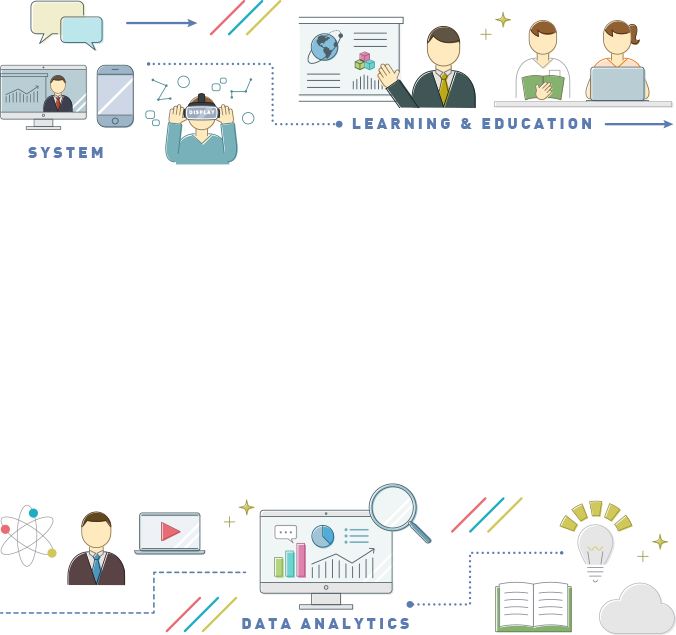Hello everyone, my name is Tang Li, and I am an M2 student.
I would like to introduce a paper we discussed in the first English literature seminar of the second semester.
In recent years, significant attention has been directed towards the evolution of learning methods through the integration of virtual reality (VR) technology and pedagogy. In this context, extensive research has explored the effectiveness of learning in virtual reality environments. The paper I am presenting here specifically investigates the educational psychology theory of the Redundancy Principle in a virtual reality environment using cutting-edge technological methods such as eye tracking and electroencephalogram (EEG). This research holds substantial implications for the future development of educational settings and learning methods.
Paper Title: Investigating the Redundancy Principle in Immersive Virtual Reality Environments: An Eye‐Tracking and EEG Study.
Journal: Journal of Computer Assisted Learning, 38.1, 120-136.
Authors: Sarune Baceviciute, Gordon Lucas, Thomas Terkildsen, Guido Makransky.
Year of Publication: 2022
Immersive virtual reality (IVR) is increasingly being adopted by institutions of higher education and corporate training, promising to enhance learner motivation and improve learning outcomes. However, despite its potential benefits, the specific instructional design principles behind IVR’s effectiveness remain elusive. While numerous studies have examined IVR, most have relied heavily on technology-centered approaches, suggesting that instructional design principles from non-immersive media may not directly apply to IVR.
The redundancy principle posits that redundant information does not aid learning but rather impedes it. Redundancy occurs when the same information is presented in multiple ways simultaneously or explained in excessive detail. However, while this principle has been identified in non-immersive media, research on its application in IVR is still insufficient. The authors argue that the mechanisms underlying how the redundancy principle affects IVR, based on findings from 2D media, remain unclear.
This study aimed to investigate the impact of redundant information on learning by comparing cognitive load and working memory demands under different learning conditions. To deepen understanding, cognitive load was assessed using eye tracking and EEG, departing from traditional self-report methods. Participants were randomly assigned to three learning condition groups (redundancy, text-only, and speech-only), and their learning outcomes were evaluated. Eye-tracking technology recorded participants’ visual attention allocation during learning, while EEG measured cognitive activity.
Results indicated that redundant information negatively affected learning effectiveness, with participants in the redundancy group exhibiting higher cognitive load and poorer learning outcomes compared to the text-only and speech-only groups. Eye-tracking data revealed that participants in the redundancy group spent more time reading text, while those in the speech-only group focused primarily on the physician character and non-task-related stimuli.
In conclusion, this study sheds light on the detrimental effects of redundant information on learning in IVR. It underscores the importance of minimizing redundancy in instructional materials to optimize learning outcomes. The paper’s recommendation to avoid excessive redundancy carries significant implications for instructional design in immersive virtual environments.
I chose this paper because it employs eye-tracking techniques to collect specific data, offering valuable insights into learners’ cognitive processes. The duration of learners’ gaze in VR environments is considered a measure of cognitive processing, with longer durations potentially correlating with better learning outcomes. Therefore, the paper’s methodology and findings are pertinent to my research plan.
However, I have several queries regarding this paper. Firstly, the authors use a subjectively felt questionnaire to investigate situations related to external attention. Nonetheless, I believe employing eye tracking would yield more objective results. Therefore, I would appreciate clarity on why the authors did not use eye tracking. Additionally, the study only discusses redundancy in terms of “text + voice,” leaving uncertainty about whether this truly produces a redundancy effect.
Moreover, the study recruited participants with normal vision and fluent English proficiency, potentially including both native and non-native English speakers. However, differences in processing between these groups may exist. For instance, native speakers might excel at listening and reading, while non-native speakers may be better at processing written text. If the study did not adequately address these differences, it is crucial to examine this aspect further.
Overall, while the study concludes that traditional redundancy principles may not directly apply to IVR, it does not delve deeply into specific IVR factors. Future research should explore participants’ linguistic backgrounds and individual characteristics, as well as employ eye-tracking technology. Proper consideration of research methodology and participant characteristics is vital to maximize IVR’s educational potential. Thus, this study marks a significant step towards understanding the educational applications of immersive virtual reality, paving the way for further research in this field.







